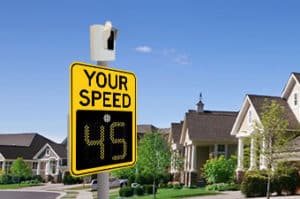Traffic engineers are tasked with designing and planning roads that safely and efficiently move traffic volumes of all kinds from one place to another. But what about when existing road design isn’t doing what it should? When cars speed, pedestrians are not sufficiently protected, or bicyclists don’t have adequate room to ride, traffic engineers have to explore new ways to keep roads safe.
from one place to another. But what about when existing road design isn’t doing what it should? When cars speed, pedestrians are not sufficiently protected, or bicyclists don’t have adequate room to ride, traffic engineers have to explore new ways to keep roads safe.
Here are five ways to make existing roads calmer and safer for everyone who uses them.
- Implement design changes– Working from the bottom up doesn’t always have to mean large structural changes. Using easy-to-install rubber devices, engineers can create traffic circles or lane narrowing to slow cars by creating the illusion of less space in narrow streets or by creating more space for pedestrians and cyclists. Installing rubber speed humps, cushions, and tables offers another alternative that offers cars no choice but to slow down to a reduced speed.
- Improve awareness– While changes to road design can be efficient in calming cars, many cities prefer not to install these devices on their roads. Improving awareness, by displaying driver speed on radar signs, has been proven to slow drivers down to a reduced vehicle speed. Oftentimes, drivers aren’t aware how fast they are driving. Displaying their speeds alongside the posted speed limit helps to remind them to slow down and obey speed laws.
- Encourage interaction– In addition to simply alerting drivers to their speeds, variable message signs offer the added benefit of providing interactive feedback to encourage safer driving. Messages like slow down, drive safe, or good job can be customized to display based on driver speed. Graphics such as a frown or smiling face as well as flashing strobes offer further ways to interact with drivers to encourage them to slow down and drive safely.
- Increase police presence– Having more police officers patrol an area is always quick to slow drivers down. But it can get expensive and pull resources away from other areas. With the SafePace cloud, all speed data can be viewed, downloaded, and analyzed online so that you know when and where speeding is of greatest concern. This eliminates the need for constant police presence while allowing for targeted enforcement where it’s needed most.
- Use automated enforcement– Speed camera systems offer cities the option to obtain real-time images of speeding cars to pinpoint dangerous speed behaviors. These images can be used to warn or penalize drivers and prevent further speeding infractions. They are often used in areas with more vulnerable road users such as school zones, work zones, and pedestrian crossings.







